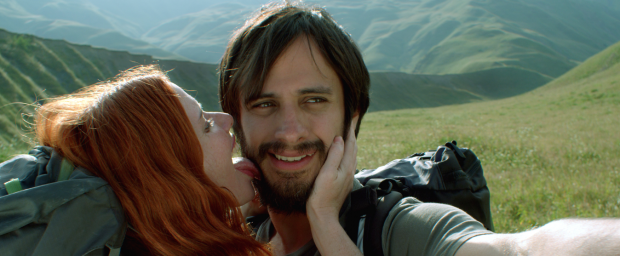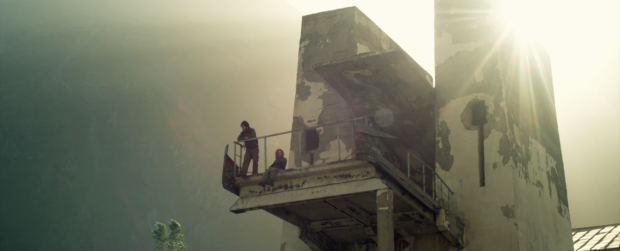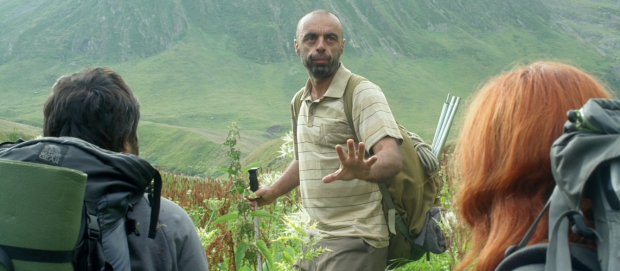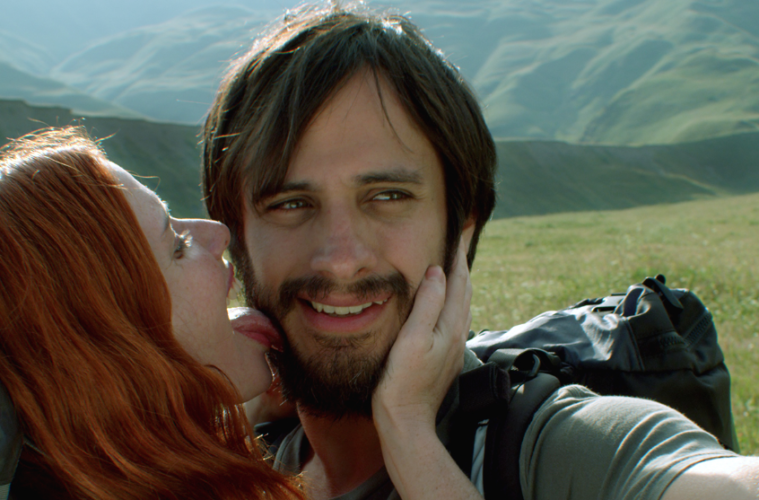Julia Loktev‘s The Loneliest Planet, which began its limited theatrical release this Friday — and which I reviewed, very favorably, right here — is one of the more striking films I’ve seen this year, and so I jumped at the opportunity to speak with writer-director Loktev as she was in New York City this week promoting the film. Having recently caught up with her previous film, the harrowing Day Night Day Night, I had plenty of conversation-starters to offer about how these two films — her only narrative efforts to date — can be viewed as eerily similar companion pieces.
Other topics of discussion included the intense physicality of the film’s shoot, the process of adapting the screenplay from Tom Bissell‘s short story “Expensive Trips Nowhere,” and the ability to locate a precise chemisty between co-leads Gael García Bernal and Hani Furstenberg, both of whom are superb in the film. Check out the full conversation below.
The Film Stage: Your film is based on a short story: Tom Bissell’s “Expensive Trips Nowhere.” What was the adaptation process like? How much did you end up diverting from the short story?
Julia Loktev: I took the central incident of the short story, which was such a provocative beginning. And then, how it’s fleshed out is constructed from other elements, very much in response to the place we were shooting, some of it based on my own travel experience. But the characters are different than they are in Tom Bissell’s short story. But the beginning – the seed – was very much from his story.
To what extent did you have prior experience with the film’s location – the Caucasus Mountains in Georgia? Had you always thought about making a movie there?
No. I mean, well, it’s more about a kind of general experience of travel. I was born in the Soviet Union – I could say Russia, but at the time it was the Soviet Union. And Georgia was part of the Soviet Union as well at the time I was born, so in a sense I was born in the same country. Now, obviously, it’s a completely different country, and it has a [conflicting] relationship with Georgia. So, for me, it was somewhere – there was always a fantasy. My parents had traveled to Georgia before I was born. My mom had hiked through the Caucasus Mountains. And I myself, I hadn’t been to Georgia, but I’d traveled through other parts of the former Soviet Union. I traveled for five months in Central Asia, for example, and went through Turkmenistan all the way to Kazakhstan. So I was very familiar with traveling in that part of the world, in a broader sense. And then I came to Georgia for a film festival – traveling with a guy at the time – and remembered this Tom Bissell short story while I was traveling. And right then it kind of seemed like, “Wow, this could make an interesting movie.”

So it was something you’d read before first visiting Georgia?
Yeah, I had read it like a year or two before going to Georgia, and wasn’t thinking about it in terms of making a movie at all. But it came back to me as I was traveling.
And then you just contacted Bissell about the project?
Exactly. I wrote him and I said, “I want to make a movie of your beautiful story. And I hope you don’t mind, but it’s going to change.” [Laughs.] And he was very understanding and said, “Yes, I know that’s what happens to stories.” But he was great. He said, “Okay, run with it.”
What was the casting process like? It’s an interesting mix of professional and non-professional actors.
Yeah, I know, it can be a total disaster that way, right? [Laughs.] But it worked out. I think the three actors or non-actors or three people – ultimately, that’s what matters. The three people – Gael [García Bernal], Hani [Furstenberg], and Bidzina [Gujabidze] – fit together so perfectly. And that’s what makes the film – the chemistry between them.
I had read somewhere that the first “script” the actors received was more of a summary outline than a screenplay. Did that develop over the course of time?
Yeah, it’s funny, [Hani] always says that, and I think part of it is that when I first write, I write the dialogue embedded in paragraphs, because I don’t like the way, in film scripts, that the dialogue is kind of set aside and raised on a pedestal. I think a physical action can mean just as much – or more – than a few words. So I tend to kind of blend it together and people would say, “Oh, well, it’s a treatment not a script.” And at one point I went through the treatment and I indented all the dialogue and suddenly everyone said, “Oh, now you have a script.” [Laughs.] And I said, “No, that’s the tab function. That’s all that is.” [Laughs.] But I do keep working on the scripts throughout the shoot – it’s an evolving process. Because I knew the core of the story, and, in some ways, it’s very rigid how it goes. It’s very structured. Maybe “rigid” isn’t the right word, but it’s very structured how it goes, and what happens is very much structured. But the fleshing out of the textures around what happens – the life that takes place around it, the context – is developed throughout working on it. And [that’s] in response very much to the place. If I see something there on location – for example, I’ll find a bridge – and I’ll say, “Okay, now we’re going to write a little scene using this little bridge.”

I imagine the shoot was probably very rough. Was it even tougher than you expected?
Oh, it was a hellish-tough shoot. So much tougher. I mean, it was by far – by far, by far – the hardest thing I’ve ever done. And there were a lot of nights when I thought, “We’re not going to be able to do this.” I thought it was going to fall apart at any moment. And somehow we kept going. Mainly, it [was about] the challenges of working with a small crew out in nature, which you can’t control. We had an amazing crew, so that wasn’t the issue. They made everything possible. They were great. But I had a very specific idea of how I wanted the film to look, and the sun wasn’t really cooperating with that idea most of the days. [Laughs.] We got hit with a heat wave. I thought we were going to have nice diffused light, and clouds all the time, which is how it was when I scouted. Then I get there, and we just had harsh, glaring sun for the entire day. So we basically ended up having to shoot in little windows, like catching the very first morning light. We’d have to hike in in the darkness; we’d be ready to go with the very first light, which was nice and even. Then [we’d] shoot for a few hours until the sun got too harsh, and then move to another mountain where we’d shoot for only another couple of hours in the afternoon. It was intense. You really had to have everything perfectly ready. But, as a result, I think the film does have a very particular visual look. So it was worth fighting for. But it’s hard to do that when – you know, it’s one thing if you’re doing that for Days of Heaven, it’s another if you’re doing that with a dozen people in the mountains on a very tiny budget. [Laughs.]
Yeah, because one of the things I like about the movie is the tiny-production attitude to it. It’s like you and a dozen other people just took a camera into the mountains and decided to see what you could come up with.
It was definitely more elaborate and more constructed than that. [Laughs.] I mean, it involved incredibly rigorous planning. For example, with the lights, we had very elaborate light charts for each location that showed us the arc of the sun – at what point it was going to come from behind the mountain, or when it’d go behind the other mountain, the line that it was going to follow. It took a lot of technical coordination, I must say.
The more I think about the film, the more fascinated I am by it as a companion piece to your previous film, Day Night Day Night, which has two major locations – a tiny motel room in the first half, and a jam-packed Times Square in the second. But in The Loneliest Planet, there’s no one around, and the location is completely isolated. And yet, each film maintains a similarly claustrophobic quality.
What is this thing I have about claustrophobia? [Laughs.] Yeah, I don’t know. I think I’m interested in emotional claustrophobia – the claustrophobia of being in this inescapable emotional situation, and the pressure of that. Then the environment becomes a way to kind of heighten that and a reflection of that and is an outgrowth of that. Or sometimes it’s working counter to that. For example, it was really important to me, in The Loneliest Planet, that it’s not set somewhere really arid and harsh. It’s actually set in this lovely, beautiful place. But perhaps there are moments in the film where the characters can’t appreciate the beauty.
Did you have the conscious intent, after making Day Night Day Night, to go film somewhere where there aren’t any people?
I totally consciously thought that. [Laughs.] I thought, “Okay, I’ve worked in the middle of Times Square. What can I do that’s opposite? Let’s go to the mountains.” [Laughs.] Now I’m thinking, “Okay, after Times Square and the mountains, let’s go to a sound stage.” [Laughs.] No, I’m kidding. But it’s certainly tempting after working in locations that are very tough for a small budget. They were really challenging conditions.

Another point of connection between the two films for me was the sense of an aversion to backstory.
I actually wouldn’t put it that way. I don’t have an aversion to backstory – I have an aversion to dialogue that’s kind of written to babysit the audience. That kind of backstory I don’t like. If there’s a way for people’s pasts to make it in in a natural way that makes sense, sure, no problem. But, in this case, these weren’t really films about people’s pasts. They were films about what is happening in the present. And the characters are in a situation where they wouldn’t really be talking about the past. It would be weird. If they did, it would just kind of be dumbing it down for the audience. In this case, it’s not there for a simple, logical reason: The film centers on a couple that’s engaged to be married, so I assume that they’re not going to be telling each other their backstories at this point. [Laughs.] They probably got that stuff out of the way before getting engaged. But you do see their relationship. I mean, one important thing is that the central turning point is not an outgrowth of anything that happened before. It comes out of the blue, and it goes counter to everything they believed about each other, about themselves, everything about their relationship. It’s not something that’s built up to.
To come back to Day Night Day Night again, that’s a film that has an event that we know is on the horizon. And, as you said, The Loneliest Planet’s conflict isn’t like that. The atmosphere is somewhat uneasy, but we still don’t see it coming at all.
No, it’s not something, certainly, that’s foreshadowed in a straightforward way.
One of the things that has consistently struck me about your style is the emphasis on sound design, and, in this film, that seems to be conjoined with the editing choices. There are many cuts, I felt, that transition us from scenes of quietude to scenes of glaring noise. Can you talk about this element of your filmmaking?
Yeah, I love sound, and I like very quiet moments, I like very loud things. I’ve gotten in trouble before. When Day Night Day Night was going to be broadcast on German and French television, they had issues with the dynamic range. And the sound designer Leslie Shatz and I had to fight for it, because they said, “Some moments are so quiet, and other moments are so loud.” And I said, “Yes, yes, it has to be this way.” [Laughs.] So they wanted it limited to kind of bring down the loud and bring up the quiet, and I was like, “No, no. We can’t do that.”

Did you get to keep your original sound levels?
We did, we won. We totally won. And yeah, I like feeling cuts. That’s one thing. That’s probably part of what you’re noticing. Very often, the conventional thing to do is to suit your cut – basically, to hide the cut by cross-fading sound, so you don’t notice when one thing goes to another. You don’t feel it, and so you’re just kind of led along and you’re flowing along. [But] I actually love to feel the difference from one scene to another, to be thrown from one space to another. I want to feel a cut, and sound is part of that. And I won’t use dissolves. Or I haven’t yet. Generally, for these two films, it didn’t feel right. So, there’s not a single dissolve between scenes. It’s a hard cut, on the cut. And that’s what you feel. It’s like, “You’re in one scene, okay, now you’re in another.”
To go back to the casting process: Who was the first actor to sign on?
I’m trying to remember. I think I may have seen Hani first, and I said I loved her but I’d have to wait until we finalized things with Gael. Because ultimately what mattered is not the individual actor but the couple and their chemistry. I hate to say it, but it does come down to that – it’s chemistry. And either people have it or they don’t. And they had really lovely chemistry from the day they met. I took a bunch of snapshots of them; I put them together in this ridiculous way. Gael was living in Madrid and Hani came to meet him for a day. I was in Spain also for a film festival. And I sent them out on a treasure hunt in the city, which is a game I’d played at a friend’s birthday party the week before. [I had them] go out in the city and find ridiculous things, like two identical dogs or a formal dress or [whatever]. So I basically followed them around Madrid and took pictures of them while they were looking for these things together. Immediately, they had this lovely, lovely chemistry, and that’s what interested me most – you could feel them as a real couple. You could feel that there was something at stake. I didn’t want a couple who seemed bored by each other. I wanted them to feel like a couple that you could just so naturally see together.
Did you allow them to improvise at all, then?
With very precise directions, yes. [Laughs.] I’m not very loose in the end. There were things where I would allow them to interact and kind of encourage them to find things. I would set up a condition. For example, there’s a scene at the beginning where they’re in a Georgian guesthouse. And it was this house that we had redecorated a bit. We moved the curtains from the neighbor’s house, because we liked the neighbor’s curtains better. We changed the bedspread with the other neighbors on the other side. [Laughs.] It was like a remixed Georgian house. [Laughs.] But the family was definitely there, and then we brought in Gael and Hani in, and we hung out at the house together. And I had very specific, fixed scenes within that that I wanted to happen – but how they would happen had to be discovered on the spot, in that interaction. Because obviously the Georgian family didn’t speak English, and Gael and Hani didn’t speak Georgian. So they really are interacting with people they don’t have a common verbal language with. But they have a common physical language, and that’s what you do. You really can survive on that, I think. Once you learn “please,” “thank you,” and smile a lot, and nod a lot, you’re golden. Until something happens. [Laughs.]
The Loneliest Planet is now in limited release.


